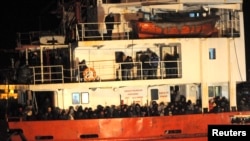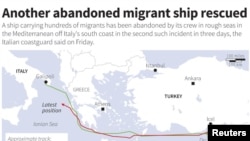Human traffickers are using a new tactic to combat a change in Italy’s approach to dealing with asylum-seekers, leaving a new wave of refugees, mainly from Syria, abandoned in ships steaming toward shore.
For the second time in a week, authorities in Italy are rescuing illegal migrants from a ship near its coast. This time, the ship carries about 450 people, believed to be mostly from Syria. On Wednesday, twice as many, also believed to be mostly Syrians, had to be rescued from a ship near another Italian port.
In both cases, all the crew members had fled, leaving the ships on auto-pilot heading toward shore.
That forced the Italian Coast Guard to rescue the passengers, and bring them into port.
End of 'Operation Mare Nostrum'
The traffickers' new tactic appears to be a response to Italy’s decision to end Operation Mare Nostrum, which had more patrol boats farther out at sea. Traffickers would put the migrants in small boats or life rafts, and the patrols would rescue them.
Professor Emeritus John Salt of University College London says by withdrawing the patrols the Italians appear to have been sending a message that, so far, migrants and traffickers are ignoring.
“By withdrawing, as they have done, from the Mare Nostrum operation, they’re sending the message that, ‘You aren’t going to be rescued, so don’t come.’ That is a longer-term solution, because there are already quite clearly people in the pipeline, who are going to come anyway," he said. "I think it remains to be seen whether in the longer run the new policy will deter or not.”
Traffickers set course for coast, then abandon ship
Italy now relies on a European Union agency called Frontex, which has far fewer resources for responding to the flow of asylum-seekers, and fewer patrol boats.
Traffickers, who charge high prices to transport illegal migrants to Europe, appear to have adapted by steering their ships toward the shore, putting them on auto-pilot, and then abandoning them. In the process, they lose their ships, but Professor Salt says the vessels are old and have little value.
“I think this new tactic has taken everybody by surprise," said Salt. "Don’t forget these things are always businesses. I don’t think we really understand how this business works.”
What seems clear is that the trafficking business is exploiting a new market among Syrian refugees in Turkey, and using a new tactic to get them into Europe.
Professor Salt says that is putting more pressure on southern European countries, mainly Italy and Greece, already burdened by the flow of African asylum-seekers and continuing hard economic times. And, as in past refugee crises, he says their allies farther north are likely to offer little more than sympathy.








